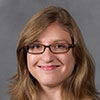This article is more than 5 years old.
A few weeks ago Lynn and I attended the Spring 2014 Membership Meeting of the Coalition for Networked Information (CNI) in St. Louis, MO. I had never attended CNI in the past, but was pleased to discover how much overlap there is with the Digital Library Federation (DLF), the community that I consider to be my professional home. Like the DLF, CNI is a rich mix of back end and front end; thought leaders and on-the-ground people; and deans, directors, department heads, and a few early career librarians.
I also gave a presentation (my first as ZSR’s Digital Initiatives Librarian!) on Wake Forest’s participation in the Digital Public Library of America, or DPLA. Although the DPLA has been very much a part of the CNI conversation in past meetings, DPLA staff delivered presentations and focused on its vision rather than its implementation. My presentation was part of a two-person panel that shifted the focus to local participation in the DPLA. Alongside Chris Freeland, Associate University Librarian at Washington University in St. Louis,who shared his experiences leading an initiative to organize a DPLA service hub in Missouri, I spoke about our approach as a contributing institution to the DPLA.
Both of our slides are below.
We contribute our collections to the DPLA via the North Carolina Digital Heritage Center service hub, which aggregates the metadata of contributing institutions across the state of North Carolina and feeds it to the DPLA. We benefit from a relationship infrastructure already in place in North Carolina that Chris and others are working to establish in Missouri. Their goal is to contribute digital collections from Missouri contributing institutions by October 2014. I’m excited to be a part of the DPLA community. It’s not just a national interface to digital collections; it’s an ethos and a movement.
Compared to other conferences I’ve attended, the #cni14s Twitter stream was particularly active—recording, commenting on, and sometimes challenging the perspectives shared by speakers. As a first time presenter, I used the Twitter stream as an informal assessment mechanism to see what talking points resonated with listeners.
https://storify.com/ararebit/local-participation-in-the-dpla-at-cni14s/

1 Comment on ‘Chelcie at CNI Spring 2014 Membership Meeting’
Excellent presentation, Chelcie. You had many people there talking about Wake Forest!